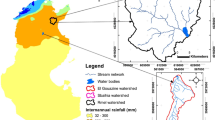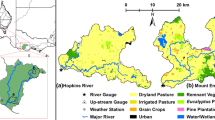Abstract
Tile drainage is a widespread practice in agriculturally dominated lowlands with naturally high groundwater tables. A realistic estimation of the stream flow composition including tile drainage is an essential precondition for identifying major flow sources of nutrients. In this study, the Soil Water Assessment Tool (SWAT) was applied to the partially tile-drained Warnow catchment in north-eastern Germany to evaluate the effect of tile drainage systems on stream flow composition on a subbasin scale. In addition, model performance was tested after excluding tile drainages from the calibrated model setup. A sensitivity analysis revealed the highest sensitivities for parameters concerning evapotranspiration, soil characteristics, and groundwater flow, with a large variability in sensitivity ranks among the subbasins. Nash-Suttcliffe-Efficiencies (NSE) varied strongly among the subbasins for the tile-drained model setup ranging from 0.22 to 0.81 for the calibration and from −0.81 to 0.66 for the validation period. The percentage of tile flow varied between 0.3 and 31.9 %, and reflected statistically significantly (p < 0.05) the spatial extent of tile-drained areas within the subbasins. Excluding tile drainages from the model setup led to a strong decrease in model quality and to a changed stream flow constitution dominated by groundwater. The results of our study indicate that the SWAT model realistically represented the actual fractions of tile flow on discharge on the subbasin scale within the Warnow catchment. Therefore, we conclude that the incorporation of tile drainage systems is essential to calculate flow components accurately.







Similar content being viewed by others
References
Arnold JG, Srinivasan R, Muttiah RS, Williams JR (1998) Large area hydrologic modeling and assessment part I: model development. J Am Water Resour Assoc 34:73–89
Behrendt H, Bachor A (1998) Point and diffuse load of nutrients to the Baltic Sea by river basins of North East Germany (Mecklenburg-Vorpommern). Water Sci Technol 38:147–155
Boskidis L, Gikas GD, Sylaois GK, Tsihrintzis VA (2012) Hydrologic and water quality modeling of Lower Nestos River Basin. Water Resour Manage 26:3023–3051
Daniel EB, Camp JV, Leboeuf EJ et al (2011) Watershed modeling and its applications: a State-of-the-Art review. Op Hydrol J 5:26–50
Di Luzio M, Arnold JG, Srinivasan R (2005) Effect of GIS data quality on small watershed stream flow and sediment simulations. Hydrol Process 19:629–650
DLR (2003) CORINE Land Cover Vectordata CLC2000. German Aerospace Center, Cologne
Du B, Arnold JG, Saleh A, Jaynes DB (2005) Development and application of SWAT to landscapes with tiles and potholes. Trans ASAE 48:1121–1133
Du B, Saleh A, Jaynes DB, Arnold JG (2006) Evaluation of SWAT in simulating nitrate nitrogen and atrazine fates in a watershed with tiles and potholes. Trans ASABE 49:949–959
Gassman PW, Reyes MR, Green CH, Arnold JG (2007) The soil and water assessment tool: historical development, applications, and future research directions. Trans ASABE 50:1211–1250
Gonzales AL, Nonner J, Heijkers J, Uhlenbrook S (2009) Comparison of different base flow separation methods in a lowland catchment. Hydrol Earth Syst Sci 13:2055–2068
Goswami D, Kalita PK, Mehnert E (2010) Modeling and simulation of baseflow to drainage ditches during low-flow periods. Water Resour Manage 24:173–191
Green CH, Tomer MD, Di Luzio M, Arnold JG (2006) Hydrologic evaluation of the Soil and Water Assessment Tool for a large tile-drained watershed in Iowa. Trans ASABE 49:413–422
Griensven AV, Meixner T, Grunwald S, Bishop T, Diluzio M, Srinivasan R (2001) A global sensitivity analysis tool for the parameters of multi-variable catchment models. J Hydrol 324:10–23
Holvoet K, Griensven AV, Seuntjens P, Vanrolleghem P (2005) Sensitivity analysis for hydrology and pesticide supply towards the river in SWAT. Phys Chem Earth 30:518–526
Hörmann G, Köplin N, Cai Q, Fohrer N (2009) Using a simple model as a tool to parameterise the SWAT model of the Xiangxi river in China. Quat Int 208:116–120
Kiesel J, Fohrer N, Schmalz B, White MJ (2010) Incorporating landscape depressions and tile drainages of a northern German lowland catchment into a semi-distributed model. Hydrol Process 24:1472–1486
Kladivko EJ, Grochulska J, Turco RF, Van Scoyoc GE, Eigel JD (1999) Pesticide and nitrate transport into subsurface tile drains of different spacings. J Environ Qual 28:997–1004
Kumar S, Merwade V (2009) Impact of watershed subdivision and soil data resolution on SWAT model calibration and parameter uncertainty. J Am Water Resour Assoc 45:1179–1196
LUNG (2007) BÜK 500, Bodenübersichtskarte 1:500,000. State Agency for the Environment, Nature Conservation and Geology of Mecklenburg-Western Pomerania (LUNG), Güstrow
LUNG (2010) BÜK 200, Bodenübersichtskarte 1:200,000. State Agency for the Environment, Nature Conservation and Geology of Mecklenburg-Western Pomerania (LUNG), Güstrow
LVA M-V (2000) DEM25, Digital Elevation Model grid size 25 × 25 m. Land survey office Mecklenburg-Western Pomerania, Schwerin
Mckay MD, Beckman RJ, Conover WJ (1979) A comparison of three methods for selecting values of input variables in the analysis of output from a computer code. Technometrics 21(2):239–245
Mehl D, Hoffmann D, Steinhäuser A (2010) Ermittlung von Art und Intensität künstlicher Entwässerung von landwirtschaftlichen Nutzflächen in Mecklenburg-Vorpommern. Biota - Institut für ökologische Forschung und Planung, Güstrow
Moriasi DN, Arnold JG, Vazquez-Amábile GG, Engel BA, Rossi CG (2009) Incorporation of a new shallow water table depth algorithm into SWAT2005. Trans ASABE 52:771–784
Morris MD (1991) Factorial sampling plans for preliminary computational experiments. Tecnometrics 33:161–174
Nash JE, Sutcliffe JV (1970) River flow forecasting through conceptual models. Part I - a discussion of principles. J Hydrol 10:282–290
Neitsch SL, Arnold JG, Kiniry JR, Williams JR (2005a) Soil and Water Assessment Tool: theoretical documentation. Temple, Texas
Neitsch SL, Arnold JG, Kiniry JR, Srinivasan R, Williams JR (2005b) Soil and water assessment tool: input/output file documentation. Temple, Texas
Northcott W, Cooke RA, Walker SE, Mitchell JK, Hirschi MC (2002) Modelling flow on a tile-drained watershed using a GIS integrated DRAINMOD. Trans ASAE, ASAE Annual International Meeting, Chicago, Illinois, 1–11
Olivera F, Valenzuela M, Srinivasan R et al (2006) Arcgis-SWAT: a geodata model and GIS interface for SWAT. J Am Water Resour Assoc 85:909–309
Refsgaard JC, Storm B (1995) MIKE SHE. In: Singh VP (ed) Computer models of watershed hydrology. Highlands Ranch, Water Research Pub, Colorado
Richter D (1995) Ergebnisse methodischer Untersuchungen zur Korrektur des systematischen Niederschlagsmeßfehlers des Hellman-Niederschlagsmessers. Berichte des Deutschen Wetterdienstes 194, Selbstverlag, Offenbach
Romanowicz AA, Vanclooster M, Rounsevell M, La Junesse I (2005) Sensitivity of the SWAT model to the soil and land use data parametrisation: a case study in the Thyle catchment, Belgium. Eco Model 187:27–39
Santhi C, Kannan N, Arnold JG, Di Luzio M (2008) Spatial calibration and temporal validation of flow for regional scale hydrologic modeling. J Am Water Resour Assoc 44:829–846
Schmalz B, Fohrer N (2009) Comparing model sensitivities of different landscapes using the ecohydrological SWAT model. Adv Geosci 21:91–98
Schmalz B, Tavares F, Fohrer N (2008) Modelling hydrological processes in mesoscale lowland river basins with SWAT–capabilities and challenges. Hydrol Sci J 53:989–1000
Shrestha NK, Shakti PC, Gurung P (2010) Calibration and validation of SWAT model for low lying watersheds: a case study on the Kliene Nete watershed, Belgium. Hydro Nepal 6:47–51
Skaggs RW (1978) A water management model for shallow water table soils. University of North Carolina, Water Resource Research Institute, Technical Report 134
Thampi SG, Raneesh KY (2010) Influence of scale on SWAT model calibration for streamflow in a river basin in the humid tropics. Water Resour Manage 24:4567–4578
Tiemeyer B, Kahle P, Lennartz B (2006) Nutrient losses from artificially drained catchments in North-Eastern Germany at different scales. Agric Water Manage 85:47–57
Tiemeyer B, Moussa R, Lennartz B, Voltz M (2007) MHYDAS-DRAIN: a spatially distributed model for small, artificially drained lowland catchments. Eco Model 209:2–20
Tiemeyer B, Lennartz B, Kahle P (2008) Analysing nitrate losses from an artificially drained lowland catchment (North-Eastern Germany) with a mixing model. Agric Ecosyst Environ 123:125–136
Tomer MD, Meek DW, Jaynes DB, Hatfield JL (2003) Evaluation of nitrate nitrogen fluxes from a tile-drained watershed in Central Iowa. J Environ Qual 32:642–653
Werner W, Olfs HW, Auerswald K, Isermann K (1991) Stickstoff- und Phosphoreintrag in Oberflächengewässer über “diffuse Quellen”. In: Hamm A (ed) Studie über Wirkungen und Qualitätsziele von Nährstoffen in Fließgewässern. Academia Verlag, Sankt Augustin, pp 665–764
Xu ZX, Pang JP, Liu CM, Li JY (2009) Assessment of runoff and sediment yield in the Miyun Reservoir catchment by using SWAT model. Hydrol Process 23:3619–3630
Zajíček A, Kvítek T, Kaplická M et al (2011) Drainage water temperature as a basis for verifying drainage runoff composition on slopes. Hydrol Process 25:3204–3215
Zhang X, Srinivasan R, Liew MV (2008) Multi-Site calibration of the SWAT model for hydrologic modeling. Trans ASABE 51:2039–2049
Zhang A, Zhang C, Fu G, Wang B, Bao Z, Zheng H (2012) Assessments of impacts of climate change and human activities on runoff with SWAT for the Huifa River Basin, Northeast China. Water Resour Manage 26:2199–2217
Acknowledgments
We greatly acknowledge the Federal Agency for Environment, Nature Conservation and Geology of Mecklenburg-Western Pomerania, especially Alexander Bachor, Frank Idler, and Stefan Klitzsch, for providing soil and discharge data. We also appreciate the constructive comments of two anonymous reviewers, which helped to improve the quality of the manuscript substantially.
Author information
Authors and Affiliations
Corresponding author
Rights and permissions
About this article
Cite this article
Koch, S., Bauwe, A. & Lennartz, B. Application of the SWAT Model for a Tile-Drained Lowland Catchment in North-Eastern Germany on Subbasin Scale. Water Resour Manage 27, 791–805 (2013). https://doi.org/10.1007/s11269-012-0215-x
Received:
Accepted:
Published:
Issue Date:
DOI: https://doi.org/10.1007/s11269-012-0215-x




